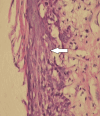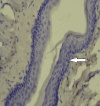Effect of Indigofera aspalathoides on the Expression of Inducible Nitric Oxide Synthase During 7,12-Dimethylbenz[a]anthracene-Induced Hamster Buccal Pouch Carcinogenesis
- PMID: 39559675
- PMCID: PMC11571105
- DOI: 10.7759/cureus.71841
Effect of Indigofera aspalathoides on the Expression of Inducible Nitric Oxide Synthase During 7,12-Dimethylbenz[a]anthracene-Induced Hamster Buccal Pouch Carcinogenesis
Abstract
Background: The mechanisms of inflammation and carcinogenesis are significantly influenced by nitric oxide (NO). Three different kinds of nitric oxide synthase (NOS) have been previously found: neuronal NOS, inducible nitric oxide synthase (iNOS), and endothelial NOS.
Objectives: This study looked into the properties of iNOS in hamster buccal pouch carcinogenesis caused by 7,12-dimethylbenz[a]anthracene (DMBA).
Methods: Thirty outbred young male Syrian golden hamsters, aged six weeks, were split into five groups at random: control (n=6), administered with ethanolic extract (n=6), DMBA+EIA (ethanolic Indigofera aspalathoides) (n=6), 0.5% solution of DMBA in liquid paraffin (n=6), and DMBA alone (n=6).
Result: In the group treated with DMBA, the mean quantity of iNOS positive foci per section was roughly 12.2+/-4.7. The DMBA-treated pouch keratinocytes showed both nuclear and cytoplasmic stainings. Neither the mineral oil-treated nor the untreated pouches (n=10) showed any signs of iNOS activity.
Conclusion: In conclusion, this work has shown that hamster pouch carcinomas induced by DMBA express iNOS. This finding raises the possibility that the emergence of chemically induced oral carcinomas is linked to iNOS expression.
Keywords: carcinoma; dmba; indigofera aspalathoides; inos; keratinocytes; nitric oxide.
Copyright © 2024, Abraham et al.
Conflict of interest statement
Human subjects: All authors have confirmed that this study did not involve human participants or tissue. Animal subjects: Annamalai University Issued protocol number 474–160/1999/CPCSEA. Conflicts of interest: In compliance with the ICMJE uniform disclosure form, all authors declare the following: Payment/services info: All authors have declared that no financial support was received from any organization for the submitted work. Financial relationships: All authors have declared that they have no financial relationships at present or within the previous three years with any organizations that might have an interest in the submitted work. Other relationships: All authors have declared that there are no other relationships or activities that could appear to have influenced the submitted work.
Figures





Similar articles
-
Correlation between inducible nitric oxide synthase and p53 expression for DMBA-induced hamster buccal-pouch carcinomas.Oral Dis. 2003 Sep;9(5):227-34. doi: 10.1034/j.1601-0825.2003.02878.x. Oral Dis. 2003. PMID: 14628889
-
Immunohistochemical expression of inducible nitric oxide synthase in DMBA-induced hamster buccal pouch carcinogenesis.Oral Oncol. 2000 Mar;36(2):221-4. doi: 10.1016/s1368-8375(99)00081-0. Oral Oncol. 2000. PMID: 10745176
-
The mRNA expression of inducible nitric oxide synthase in DMBA-induced hamster buccal-pouch carcinomas: an in situ RT-PCR study.Int J Exp Pathol. 2002 Jun;83(3):133-7. doi: 10.1046/j.1365-2613.2002.00222.x. Int J Exp Pathol. 2002. PMID: 12383192 Free PMC article.
-
The mRNA expression of inducible nitric oxide synthase in DMBA-induced hamster buccal-pouch carcinomas using reverse transcription-polymerase chain reaction.J Oral Pathol Med. 2002 Feb;31(2):82-6. doi: 10.1046/j.0904-2512.2001.00034.x. J Oral Pathol Med. 2002. PMID: 11896828
-
Expression of survivin and XIAP for DMBA-induced hamster buccal pouch squamous cell carcinogenesis is associated with p53 accumulation.Oral Oncol. 2008 Jan;44(1):43-9. doi: 10.1016/j.oraloncology.2006.12.009. Epub 2007 Feb 15. Oral Oncol. 2008. PMID: 17306609
References
-
- NEW: Haschek and Rousseaux's Handbook of Toxicologic Pathology, Volume 1: Principles and Practice of Toxicologic Pathology, 4th Edition - 2021. Haschek-Hock WM, Rousseaux CG, Wallig MA, Bolon B. Int J Toxicol. 2022;41:253–254. - PubMed
-
- Angiogenesis in cancer. Nishida N, Yano H, Nishida T, Kamura T, Kojiro M. https://pubmed.ncbi.nlm.nih.gov/17326328/ Vasc Health Risk Manag. 2006;2:213–219. - PMC - PubMed
LinkOut - more resources
Full Text Sources
